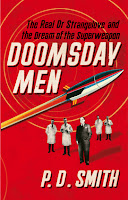Antoine Bousquet has a fascinating post at Disorder of Things on developments in neuroscience and how they are being used by militaries to 1) enhance their own soldiers and 2) degrade the abilities of their opponents. The post is in response to a report by The Royal Society on Neuroscience, Conflict and Security which outlines these developments, speculates on the future and the ethical implications of these developments.
As Bousquet notes, it’s some pretty hairy stuff:
Yet perhaps the most potentially consequential developments will be found in the area of neural interfacing and its efforts to bring the human nervous system and computing machines under a single informational architecture. The report’s authors note here the benefits that accrue from this research to the disabled in terms of improvements to the range of physical and social interactions available to them through a variety of neurally controlled prosthetic extensions. While this is indeed the case, there is a particular irony to the fact that the war mutilated (which the Afghan and Iraq conflicts have produced in abundance – according to one estimate, over 180,000 US veterans from these conflicts are on disability benefits) have become one of the main testing grounds for technologies that may in the future do much more than restore lost capabilities. Among one of the most striking suggestions is that:
electrode arrays implanted in the nervous system could provide a connection between the nervous system of an able-bodied individual and a specific hardware or software system. Since the human brain can process images, such as targets, much faster than the subject is consciously aware, a neurally interfaced weapons systems could provide significant advantages over other system control methods in terms of speed and accuracy. (p.40)
In other words, human brains may be harnessed within fire control systems to perform cognitive tasks before these even become conscious to them. Aside from the huge ethical and legal issues that it would raise, one cannot but observe that under such a scheme the functional distinction between human operator and machine seems to collapse entirely with the evaporation of any pretense of individual volition.
Noting scientific developments aimed at altering the sensory perception of enemies on the battlefield, Bousquet concludes: “The holy grail of military neuroscience is therefore nothing less than the ability to directly hack into and reprogram a target’s perceptions and beliefs, doing away even with the need for kinetic force. So that when neural warfare does truly arrive, we may not even know it.”
A couple of thoughts:
First, The Royal Society Report is interesting for its inclusion of a relatively decent overview of the applicable law that would apply to such weapons. Ken Anderson at Lawfare disagrees – suggesting that “The legal and ethical issues are of course legion and barely explored.” However, considering the report is relatively brief, the legal and ethical section does proportionally take up a large chunk of it. in addition, the report includes no less than four recommendations for suggesting improvements to the Chemical Weapons Convention and Biological Weapons Convention regimes. Interestingly, they do not suggest any improvements for law of war/IHL as opposed to arms control. I find this surprising to a certain extent. While there are principles that always apply to ALL weaponry (distinction, proportionality and necessity – and, of course, prohibition of unnecessary suffering), I would argue that neuro-non-leathal weapons are a definite grey area. (As The Royal Society report notes, altering someone’s sensory perception has radical implications for notions of responsibility in the prosecution of war crimes.)
Second, Bousquet’s last point is interesting in that it reflects the constant quest over the last century and a half to develop weapons that would end the need for the use of kinetic force. I’m presently reading P.D. Smith’s Doomsday Men a social history of the application of science to warfare and weapons of mass destruction which traces the development and logic behind such weapons that were supposed to be so terrible that they could never be used – or if used, would be so terrible as to inspire an end to warfare. This was the case for chemical/gas weapons and eventually the atomic bomb – the thought behind many of their creators that their mere possession would be enough to stop countries from fighting one another full-stop because the consequences would be so terrible.
As Smith demonstrates in his book, such a theory of non-use of weapons was a frequent theme of the science fiction literature of the time, particularly that of HG Wells:
The United States of America entered World War I under the slogan of ‘the war to end all wars’. Never has idealism been so badly used. From Hollis’ Godfrey’s The Man Who Ended War (1908) to H.G. Wells’s The World Set Free (1914), the idea of fighting a final battle to win universal peace had gripped readers in Europe and America. Wells’s novel even introduced the phrase ‘war that will end war’.
Once again, science played a vital role in these stories. A new figure emerged in pre-war fiction – the saviour scientist, a Promethean genius who uses his scientific knowledge to save his country and banish war forever. It is the ultimate victory for Science and Progress…
As James writes, these works of science fiction promoted the idea that “through revolutionary science and the actions of an idealistic scientist, war could be made a thing of the past.” In some works a terrible war is required to win the peace through science, but it is clear that in the view of many of these pre-War “science romance” novels (which would go on to inspire many of the future atomic scientists working on the nuclear bomb) that super weapons could stop war.
Should we then read neuro-weapons in this light – as part of the constant scientific quest to develop weapons which will end the need to fight?
Stephanie Carvin is an Associate Professor of International Relations at the Norman Paterson School of International Affairs. Her research interests are in the area of international law, security, terrorism and technology. Currently, she is teaching in the areas of critical infrastructure protection, technology and warfare and foreign policy.
Stephanie holds a PhD from the London School of Economics and published her thesis as Prisoners of America’s Wars: From the Early Republic to Guantanamo (Columbia/Hurst, 2010). Her most recent book is Science, Law, Liberalism and the American Way of Warfare: The Quest for Humanity in Conflict” (Cambridge, 2015) co-authored with Michael J. Williams. In 2009 Carvin was a Visiting Scholar at George Washington University Law School and worked as a consultant to the US Department of Defense Law of War Working Group. From 2012-2015, she was an analyst with the Government of Canada focusing on national security issues.
Stacie Goddard



0 Comments